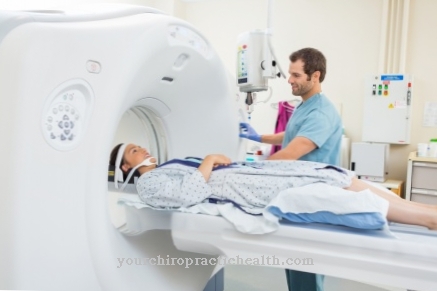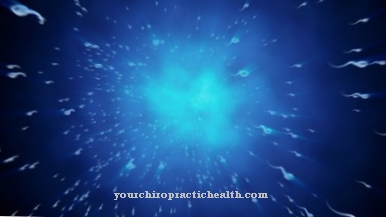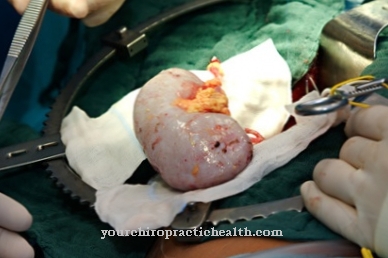The human eye is a complex, highly functional mechanism, the functionality of which depends on the nature and interaction of its individual parts. As is well known, the eye, that is, the eyeball, is embedded in a bony, almost conical eye socket. The eyeball, which is stored in fat and surrounded by the eye muscles, is closed at the front by the cornea, which merges into the conjunctiva, against the anterior chamber, which lies behind it and is filled with a clear liquid, which in turn is bounded to the rear by the differently colored iris with the pupil opening.
See through the eyes

Behind this iris, the lens divides the anterior chamber from the inside of the eye, which is completely filled by the clear glass body. This glass body ensures constant internal pressure and is in front of the light-sensitive retina.
Normal vision is now dependent on the size of the eyeball, the position of the lens, etc. It is well known that errors in this interaction can be corrected using individually prescribed eyeglasses or glasses. However, this requires precise knowledge of the conditions inside the eye. For a corresponding diagnosis, the doctor needs, in addition to in-depth knowledge, numerous technical aids that fascinate some patients when they enter the examination room.
Treatment methods
The most frequently used devices are the slit lamp and the ophthalmoscope. Many pathological changes in the anterior segment of the eye, which cannot be seen with the naked eye, become visible to the doctor under the collected (focused) light beam of the slit lamp. Until the middle of the last century it was not possible to look inside the eye to diagnose pathological changes. It was only with the revolutionary invention of the ophthalmoscope by Helmholtz that doctors could also directly examine the interior of the eyes. Like many great inventions, this one is based on an actually quite simple, uncomplicated principle.
Light is thrown through a round, slightly curved mirror into the eye to be examined, reflected at the fundus and passed through a small hole in the middle of the mirror into the eye of the examining doctor. This is how the back wall of the eye expands in front of the doctor. He can see the entry of the optic cord into the eye, the retina containing the sensory cells and the blood vessels, control their condition and then determine his actions.
Nevertheless, the ophthalmoscope, without which the modern ophthalmologist can hardly be imagined, has limits to its field of application. The prerequisite for an examination with the ophthalmoscope are clear, transparent anterior sections of the eye. However, if the cornea or lens is clouded by disease or injury and has become opaque as a result, the ophthalmoscope will also fail. However, precise knowledge of the inner eye is particularly important with such diseases.
For example, a corneal overplant or cataract surgery is only useful and promising if the retina, i.e. the part of the eye that receives the sensory impressions, has not been injured. If the retina was detached for a long time and therefore no longer properly nourished, the eye would no longer be able to see even after the opacity had been removed. In this case, the patient could be spared futile hopes and the burden of an operation.
You can find your medication here
➔ Medicines for eye infectionsUltrasound examination
Just a few decades ago, there was no way for the doctor to determine such a detachment of the retina before the operation. Only the use of ultrasound diagnosis gave him an opportunity to "see" behind the clouded cornea or lens. Ultrasound is the term used to describe sound waves that are beyond the limit of human audibility, i.e. have a higher frequency (number of vibrations per second) than 16,000. These high frequencies, we usually work with 8 to 15 million oscillations per second, are generated by oscillating quartz plates that are set in motion with the help of electrical impulses.
The application of ultrasound in medical diagnostics is based on the findings of echo sounding. In contrast to audible sound, ultrasound is difficult to conduct through air. It has therefore been used in solid and liquid media, for example to determine ocean depths or for material testing. If an ultrasonic wave hits an interface between two media, for example water and the seabed, it is partially reflected, returns to the transmitter and can be read on a screen here. The depth of the sea can be calculated from the time elapsed between the transmission pulse and the return of the reflected wave.
Ultrasound diagnostics in ophthalmology now also work according to this principle, since the eye is more easily accessible to this examination technique than any other human organ. In this case the eye is to be regarded as a water-filled sphere with a very regular border, to which the mentioned technique of the echo sounder can be transferred without difficulty.
The ultrasound device that is used in medicine consists of the power supply part, the transmitter, the receiver and the display system. While the transmitter generates electrical impulses that are sent to the transducer placed on the eye, the transducer converts the impulses into ultrasound and sends them to the examination subject. The reflected sound waves are picked up again by the transducer, converted and sent to the device. A monitor or computer makes the sound waves reflected from the fundus visible and displays them graphically as an echo curve.
An ultrasound scan is harmless as it does not involve surgery on the eye needs to be opened. The patient lies down on a couch and fixes an arrow projected onto the ceiling with his unity eye so that the eye is as still as possible during the examination. After the eye to be examined has been made insensitive with a few anesthetic drops, the transducer is placed lightly on the eye. The examination then proceeds in several directions, that is, the transducer is placed one after the other at different points, but always in such a way that the sound beam is directed through the center of the eye and hits the posterior wall perpendicularly.
The result is immediately read on the device and recorded on a photographic or digital basis.Of the diseases that can be diagnosed with ultrasound, one has already been mentioned, namely the detachment of the retina, which can lead to loss of vision. In this case, fluid has penetrated between the detached retina floating in the vitreous humor and the posterior wall of the eye, which does not produce any echoes on the computer, but allows the retinal echo to appear in a place where it should not normally occur.
Another condition that can be detected with ultrasound is growth in the eye. They arise from the dense tissue of the tumor. The echogram of an old bleeding in the eye looks very similar. Both are determined by appropriate investigation methodology, e.g. differentiated from each other by different high transmission power. It is even possible to use the echo sounder to calculate the height of a tumor that has already been detected in the eye and also to determine the entire length of the eyeball. Foreign bodies in the eye can also be identified and further examinations can be carried out. With this method, it has been possible for some time to open up the formerly invisible inside of the eye when the precise examination is cloudy and thus to enrich ophthalmology with another valuable diagnostic option.













.jpg)

.jpg)
.jpg)











.jpg)